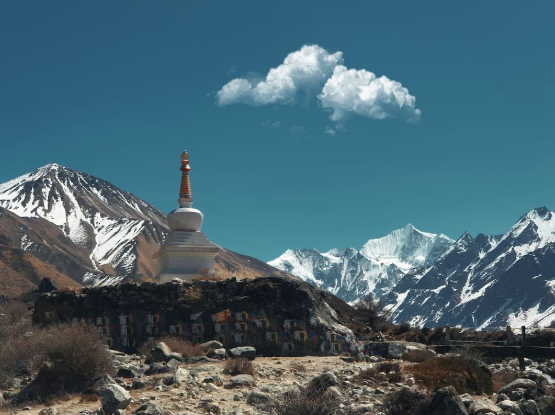The Langtang Valley Trek, nestled in Nepal’s central Himalayas, offers trekkers a unique blend of natural beauty, cultural richness, and relatively accessible terrain. Whether you’re a seasoned hiker or a first-time trekker, understanding the cost breakdown is crucial for planning a successful journey. This guide provides a detailed overview of the expenses associated with the Langtang Valley Trek in 2025, catering to various budgets and preferences.
🏞️ Overview of the Langtang Valley Trek
The Langtang Valley Trek is renowned for its breathtaking landscapes, including lush forests, alpine meadows, and panoramic views of snow-capped peaks. The journey typically spans 7 to 10 days, starting from Kathmandu and concluding back in the capital. The trek is suitable for trekkers with moderate fitness levels and offers an immersive experience into the local Tamang culture.
💰 Detailed Cost Breakdown
1. Permits and Fees
To trek in the Langtang region, trekkers are required to obtain the following permits:
- Langtang National Park Entry Permit: NPR 3,000 (approximately USD 30) for foreigners; NPR 1,500 (approximately USD 15) for SAARC nationals.
- TIMS (Trekkers’ Information Management System) Card: NPR 1,000 (approximately USD 10) for individual trekkers.
These permits are mandatory and can be obtained in Kathmandu or at checkpoints en route to Syabrubesi .
2. Transportation
The journey to the trek’s starting point, Syabrubesi, involves a road trip from Kathmandu:
- Local Bus: NPR 700–1,200 (USD 6–10) per person (one way).
- Private Jeep: NPR 10,000–15,000 (USD 75–115) for a shared ride among 5–7 people (one way).
The return trip costs are similar, depending on the mode of transportation chosen .
3. Accommodation
Accommodation along the Langtang Valley Trek is primarily in teahouses:
- Teahouse Lodging: NPR 500–1,500 (USD 4–12) per night.
- Total for 7–10 days: Approximately USD 30–120.
It’s important to note that prices may increase with altitude due to logistical challenges .
4. Meals and Drinks
Meals are available at teahouses along the trail:
- Breakfast: NPR 300–500 (USD 2.50–4).
- Lunch and Dinner: NPR 400–700 (USD 3–6) per meal.
- Daily Food Expenses: NPR 1,500–2,500 (USD 12–20).
Bottled water and hot drinks like tea or coffee are also available, with prices varying based on altitude .
5. Guide and Porter Services
Hiring a guide and/or porter enhances the trekking experience:
- Guide: USD 25–35 per day, including their food, accommodation, and insurance.
- Porter: USD 15–25 per day, including their food, accommodation, and insurance.
- Combined Guide-Porter: USD 20–35 per day .
Tips for guides and porters are customary and should be factored into the budget.
6. Miscellaneous Expenses
Additional costs to consider include:
- Travel Insurance: USD 50–100 for a 2-week trek, covering medical emergencies and evacuations.
- Gear Rental: USD 1–10 per day for items like sleeping bags, down jackets, and trekking poles.
- Wi-Fi and Charging: USD 2–5 per session.
- Snacks and Drinks: USD 5–10 per day.
- Contingency Fund: USD 100–150 for unforeseen expenses .
📊 Estimated Total Costs
| Budget Category | Estimated Cost (USD) |
| Budget Trekker | $240–400 |
| Mid-Range Trekker | $465–800 |
| Luxury Trekker | $1,030–1,540 |
These estimates encompass permits, transportation, accommodation, meals, guide/porter fees, and miscellaneous expenses .
✅ Tips for Budget-Friendly Trekking
- Travel in a Group: Sharing costs for transportation and guide/porter services can significantly reduce expenses.
- Off-Season Trekking: Consider trekking during the off-peak seasons (monsoon and winter) for lower accommodation and service costs.
- Rent Gear: Renting trekking gear in Kathmandu can be more cost-effective than purchasing new equipment.
- Carry Snacks: Bringing packaged snacks from Kathmandu can help avoid higher prices on the trail.
- Purify Water: Using a water filter or purification tablets can reduce the need to purchase bottled water .
🧭 Conclusion
The Langtang Valley Trek offers an affordable and enriching Himalayan experience. By understanding the cost breakdown and planning accordingly, trekkers can enjoy the stunning landscapes and cultural heritage of the Langtang region without overspending. Whether you’re trekking on a tight budget or seeking a more luxurious experience, the Langtang Valley accommodates all preferences.
🔑 Key Takeaways
- Permits: Essential for trekking in the Langtang region; costs approximately USD 40–50.
- Transportation: Local buses are the most economical option; private jeeps offer more comfort at a higher cost.
- Accommodation: Teahouses provide basic lodging; prices increase with altitude.
- Meals: Budget around USD 12–20 per day for food expenses.
- Guide/Porter Services: Enhance safety and experience; costs range from USD 25–35 per day for a guide.
- Miscellaneous Expenses: Include insurance, gear rental, and contingency funds.
Frequently Asked Questions (FAQs)
Q1: Is it necessary to hire a guide for the Langtang Valley Trek?
Yes, hiring a licensed guide is mandatory for all trekkers in Nepal. Guides enhance safety, provide cultural insights, and assist with navigation.
Q2: Can I trek solo in the Langtang Valley?
Solo trekking is prohibited in Nepal. A licensed guide must accompany all trekkers.
Q3: What is the best time to trek the Langtang Valley?
The ideal trekking seasons are spring (March–May) and autumn (September–November) when the weather is stable, and views are clear.
Q4: Are there ATMs along the Langtang Valley Trek?
ATMs are available in Kathmandu and Syabrub

